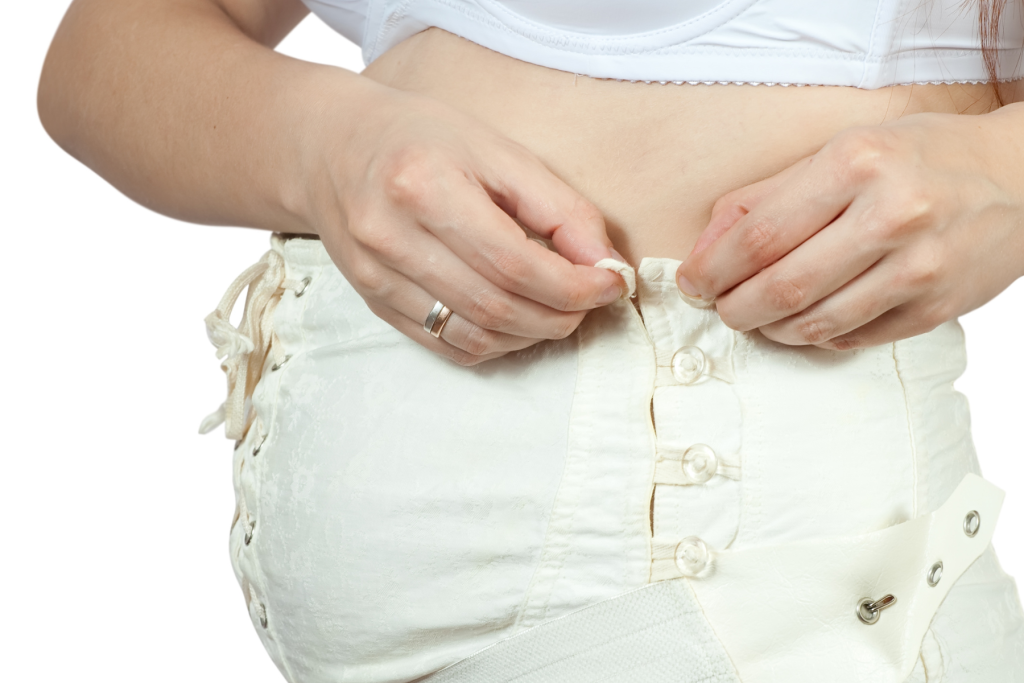Discover the potential risks and precautions associated with wearing a postpartum belt.
Are There Any Risks or Precautions Associated with Wearing a Postpartum Belt?

Congratulations on your new bundle of joy! Now that you’ve entered the world of motherhood, it’s time to tackle the challenges that come with postpartum recovery. One popular tool many new moms turn to is the postpartum belt. But before you start strapping it on, it’s important to understand the purpose, potential risks, and necessary precautions associated with wearing a postpartum belt. So, let’s dive into the nitty-gritty details, shall we?
Understanding the Purpose of a Postpartum Belt
First things first, let’s talk about why postpartum belts exist in the first place. These belts are designed to provide support and stability to your abdomen and lower back during the recovery period after childbirth. They can help alleviate discomfort by offering gentle compression and reducing swelling. Additionally, a postpartum belt can assist in realigning your abdominal muscles, providing extra support to your weakened core muscles.
After giving birth, your body goes through numerous changes as it adjusts to no longer carrying a baby. Your abdominal muscles, which stretched and expanded during pregnancy, need time to heal and regain their strength. This healing process can take weeks or even months, and during this time, a postpartum belt can be a valuable aid in your recovery.
One of the key roles of a postpartum belt is to offer support to your abdominal muscles, promoting proper posture and helping relieve strain on your back. By providing gentle compression, the belt encourages your abdominal muscles to heal and regain strength more quickly. This support can be especially beneficial if you had a cesarean delivery, as it can help reduce discomfort and promote healing in the incision area.
Wearing a postpartum belt can also make you feel more secure and supported as you go about your daily activities. It can give you a sense of stability, both physically and emotionally, during a time when your body may feel different and unfamiliar.
The Role of a Postpartum Belt in Recovery
Postpartum belts play a crucial role in the recovery process by providing the necessary support and stability your body needs. They can help you regain your pre-pregnancy shape by assisting in realigning your abdominal muscles and reducing swelling. By promoting proper posture, a postpartum belt can also help prevent or alleviate back pain, which is common during the postpartum period.
Furthermore, wearing a postpartum belt can have a positive impact on your mental well-being. It can boost your confidence and self-esteem by providing a sense of control over your body’s recovery. Knowing that you have additional support can make it easier to navigate the physical and emotional challenges that come with postpartum healing.
It’s important to note that a postpartum belt is not a substitute for proper rest and self-care. While it can provide support and aid in your recovery, it’s essential to listen to your body and give it the time it needs to heal naturally. Gradual weight loss and strengthening of your abdominal muscles should be approached with patience and a holistic approach that includes a balanced diet, exercise, and self-care.
Common Misconceptions About Postpartum Belts
Now, let’s clear up some misconceptions surrounding postpartum belts. Contrary to popular belief, these belts won’t magically help you shed those extra pregnancy pounds. They are not a shortcut to weight loss. Instead, think of them as a supplementary tool that aids the recovery process. Remember, your body needs time to heal properly, and that includes gradual weight loss.
Another misconception is that wearing a postpartum belt for an extended period will make your abdominal muscles lazy. On the contrary, it’s essential to strike a balance. Give your body time to heal naturally as well, so you don’t become overly dependent on the belt. It’s like taking the training wheels off a bike—you eventually want to ride on your own!
Postpartum belts are designed to provide support and aid in your recovery, but they are not a long-term solution. As your body heals and regains strength, you will gradually rely less on the belt. It’s important to listen to your body and consult with your healthcare provider to determine the appropriate duration of postpartum belt usage for your specific needs.
Remember, every woman’s postpartum journey is unique, and what works for one person may not work for another. It’s crucial to prioritize your physical and mental well-being during this time and choose the recovery methods that feel right for you. Whether you decide to use a postpartum belt or not, be kind to yourself and give yourself the time and support you need to heal and adjust to your new role as a mother.
Potential Risks of Wearing a Postpartum Belt
While postpartum belts offer numerous benefits, it’s crucial to be aware of any potential risks or side effects. Understanding the physical risks and psychological implications associated with postpartum belt use can help you make an informed decision about whether or not to incorporate it into your postpartum recovery routine.
Physical Risks and Side Effects
Applying too much pressure by tightening the belt excessively can lead to discomfort or even pain. It’s important to remember that a postpartum belt should provide support without constricting your breathing or circulation. The purpose of the belt is to gently compress and support your abdominal muscles, not to squeeze them tightly. By finding the right balance of compression, you can avoid any potential physical discomfort.
Additionally, wearing a postpartum belt for extended periods without taking breaks can cause skin irritation. The constant pressure and friction against your skin can lead to redness, itching, or even rashes. To prevent this, it’s essential to listen to your body and give it some breathing room. Take breaks from wearing the belt and allow your skin to breathe and recover.
Furthermore, it’s worth noting that relying solely on a postpartum belt for core strength and recovery may not be the most effective approach. While the belt can provide temporary support and stability, it’s important to engage in other postpartum exercises and activities that promote overall muscle strength and flexibility. Incorporating a variety of exercises, such as pelvic floor exercises, gentle stretching, and low-impact cardiovascular activities, can help you achieve a well-rounded recovery.
Psychological Implications of Postpartum Belt Use
It’s necessary to keep an eye out for any psychological implications associated with postpartum belt use. Some moms might feel a sense of reliance on the belt, fearing that their abdominal muscles won’t recover without it. These concerns can impact your confidence and mental well-being.
It’s important to remember that your body is resilient and capable of healing. While a postpartum belt can provide support and aid in your recovery, it’s essential to maintain a balanced perspective. Recognize that the belt is just one tool in your postpartum journey and that your body has its own innate ability to heal and regain strength.
Engaging in positive self-talk and seeking emotional support from loved ones can help alleviate any anxieties or worries you may have regarding your postpartum recovery. Remember that every woman’s postpartum journey is unique, and there is no one-size-fits-all approach. Trust in your body’s natural healing process and give yourself the time and patience needed to recover fully.
Necessary Precautions When Using a Postpartum Belt
Now that we’ve discussed the potential risks, let’s explore some necessary precautions to ensure safe and effective usage.
Postpartum belts have gained popularity among new mothers as a way to provide support and aid in the recovery process after giving birth. These belts are designed to help shrink the uterus, support the abdominal muscles, and provide back support. However, it’s important to use them correctly and take certain precautions to avoid any potential issues.
Correct Sizing and Fit
When choosing a postpartum belt, make sure to select the appropriate size for your body. A belt that’s too tight can cause discomfort, while one that’s too loose won’t provide the necessary support. Follow the manufacturer’s sizing guide and measure your post-baby waistline for accuracy.
It’s important to note that your body goes through remarkable changes during and after pregnancy. Your waistline may have expanded during pregnancy, and it may take some time for it to return to its pre-pregnancy size. Don’t be discouraged if the size you wore during pregnancy doesn’t fit you anymore. Embrace your new shape, and choose a postpartum belt that accommodates your body’s needs.
Additionally, consider the adjustability of the belt. Look for belts that offer multiple closure options or adjustable straps, as this will allow you to customize the fit as your body changes throughout the postpartum period.
Duration and Frequency of Use
While it’s tempting to wear your postpartum belt day and night, it’s essential to give your body breaks. Listen to your body’s cues and take off the belt when you’re resting or sleeping. This allows your abdominal muscles to engage without relying solely on the support provided by the belt.
Experts recommend gradually increasing the duration and frequency of belt usage as your recovery progresses. Start by wearing the belt for shorter periods, such as a few hours a day, and gradually increase the time as your body adjusts. This will help prevent overdependence on the belt and allow your muscles to regain strength naturally.
It’s also worth noting that postpartum belts are not meant to be a long-term solution. They are designed to provide support during the initial weeks or months after giving birth. As your body heals and strengthens, you should aim to reduce the reliance on the belt and focus on exercises that promote natural muscle recovery.
Remember, every woman’s postpartum journey is unique, and what works for one person may not work for another. It’s always a good idea to consult with your healthcare provider before using a postpartum belt to ensure it’s suitable for your specific needs and recovery process.
Consulting Healthcare Professionals
When in doubt, it’s always best to consult your healthcare professionals for personalized advice.
When to Seek Medical Advice
If you experience excessive pain, discomfort, or any concerning symptoms while wearing a postpartum belt, reach out to your healthcare provider. They can evaluate your specific situation and offer guidance tailored to your needs.
Role of Healthcare Professionals in Postpartum Recovery
Your healthcare team plays a vital role in your postpartum recovery. They are well-equipped to answer any questions or concerns you may have about using a postpartum belt. Don’t hesitate to seek their professional advice to ensure you have the appropriate support throughout your recovery journey.
Alternatives to Postpartum Belts
While postpartum belts can be beneficial, they are not the only option available to aid your recovery.

Natural Recovery Methods
There are several natural recovery methods you can explore alongside or instead of using a postpartum belt. Gentle exercises, such as pelvic floor exercises and walking, can positively impact your recovery. Additionally, maintaining a healthy diet and getting plenty of rest are vital for your body’s healing process.
Other Postpartum Support Products
If postpartum belts aren’t quite your cup of tea, there are other support products available in the market. Belly wraps, support pants, and compression garments can offer similar benefits and may be more suitable for your individual needs. Explore your options and find what works best for you.
So, dear new mom, while using a postpartum belt can be a helpful tool in your recovery journey, it’s essential to be aware of both the benefits and risks associated with wearing one. Remember to consult your healthcare professionals, take necessary precautions, and give your body the time and space it needs to heal naturally. Embrace this incredible postpartum phase and enjoy every moment of your journey towards regaining your strength and confidence!



